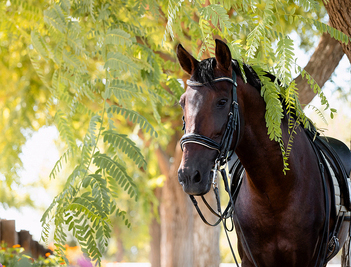Ticks on horses
What are ticks on horses?
Ticks are blood-sucking parasites that attach themselves externally to animals. In NZ, we have nine species of ticks, eight of which are native and one which was introduced. Most of these are seabird ticks, but there is also the tuatara and kiwi tick. The tick that mainly affects pets, cattle, sheep and horses is the introduced tick Haemaphysalis longicornis or the Cattle tick. This article will focus on the Haemaphysalis longicornis (the tick) and its effect on horses.
What happens in the tick life cycle?
The cattle tick is classed as a three-host tick, meaning it has to go through 3 different life stages:- larvae, nymph and adult, feeding off three different hosts, and these may not all be the same species.
- Larvae - The female tick lays eggs which will attach to vegetation. They hatch into larvae, travel to the tips of vegetation, and when an animal or host passes, they will attach themselves to it. The tick will then begin its first stage of growth and will feed here till they fall off, back onto the pasture to turn into the next stage, a nymph.
- Nymph - The nymph and adult will follow the same cycle as the larvae, finding a new host to feed where they will fall off again.
- Adult - At the adult stage, they will grow up to 9mm x 7mm once fully gorged with blood. When they fall off this time, they are ready to lay their eggs and start the cycle again.
On a horse, ticks are a problem in the ears and areas that come into contact with the vegetation, such as the legs, underbelly and groin. They can cause anything from mild irritation to severe bacterial infection if the skin is damaged and disease can enter. If there is an infestation, they can cause anaemia, loss of condition and, in extreme cases, death.
What can you do to help?
You can remove the tick to reduce its effects on your horse.
- Using fine-tipped tweezers or your hands, grab the tick as close to the mouth as possible.
- Do not grab around its swollen body, as you could squeeze blood back into the animal, which could be infected.
- Pull the tick straight out gently until its mouth lets go. Do not twist or yank the tick as it may break off, leaving part of the mouth or head still attached and could lead to further complications such as infection.
In Natural Pets Agripathic range of remedies, we have a homeopathic blend for ticks and lice. T & L is designed for horses' external parasite complaints from ticks and lice. It can be individually feed or trough treated and is a popular remedy, especially in summer. Not only can you give it to your horse, but all your animal - cattle, sheep, cats, dogs and chickens.
Recent Articles

20% Off
All Cat Remedies
Lorem Ipsum is simply dummy text of the printing and typesetting industry. Lorem Ipsum has been the industry's standard dummy text ever since the 1500s, when an unknown printer took a galley of type and scrambled it to make a type specimen book. Lorem ipsum dolor sit amet, consectetur adipiscing elit. Vivamus leo ante, consectetur sit amet vulputate vel, dapibus sit amet lectus.



 Earn loyalty points everytime you shop
Earn loyalty points everytime you shop

